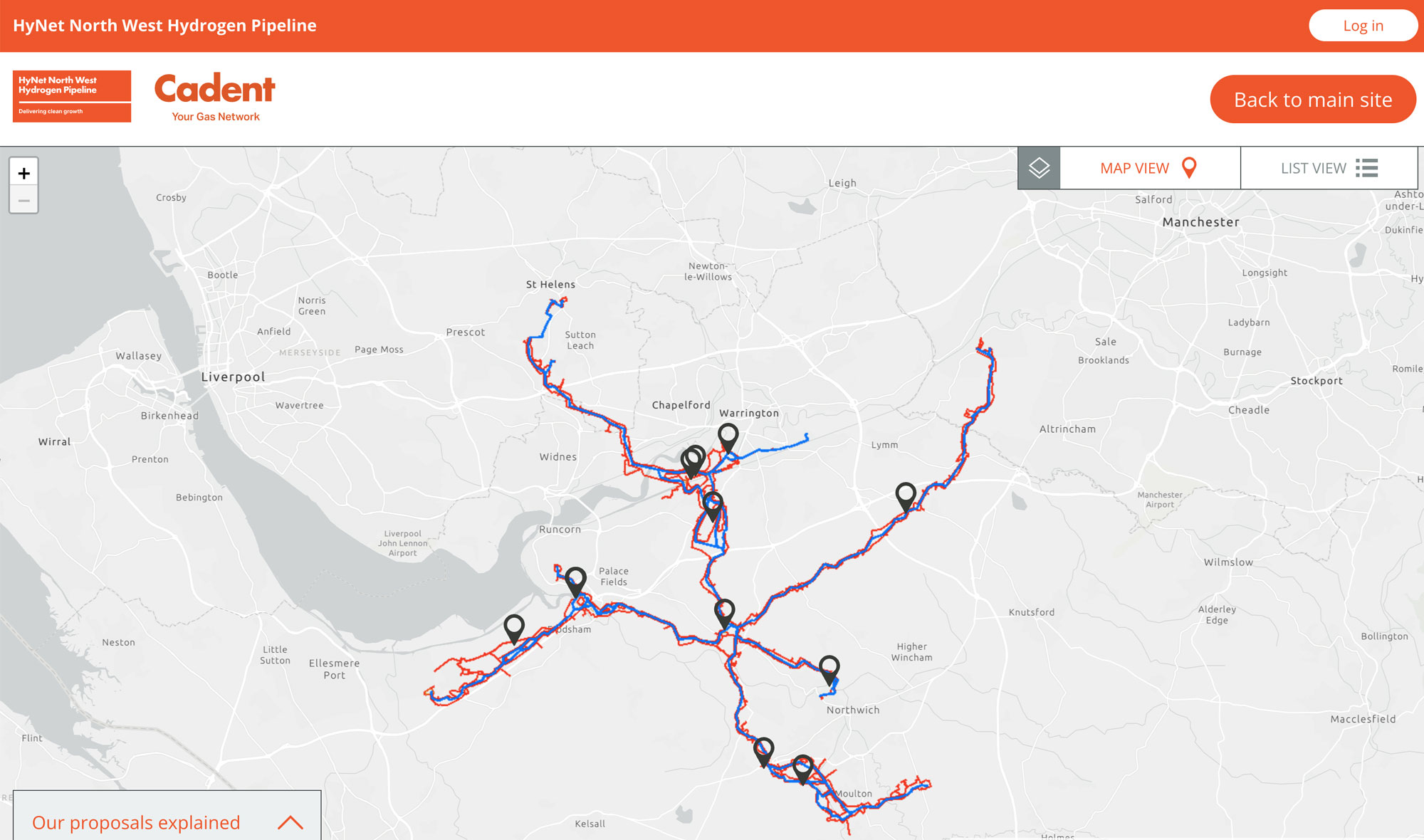How we developed our proposals
Assessment of alternative route corridors
In developing our route corridor (as shown here), we also assessed and ruled out three alternative route corridors. Below, the route corridor we are consulting on is labelled ‘A’. Alternatives that were ruled out are labelled ‘B’, ‘C’ and ‘D’. We’ve provided an explanation for why B, C and D were ruled out and why we decided to move forward with A.
All alternative route corridors were developed with consideration to a range of technical, environmental and cost factors. They were also developed with the same objective in mind – to deliver hydrogen to defined end points.
For more information about how we developed our proposals, please refer to our Route Corridor Study.
| A | This is the route corridor we are consulting on. It roughly forms an ‘X’ shape, with a Central Hub and four legs: west to Stanlow; north to St Helens; east to Partington and Warburton; and south towards Middlewich. |
|---|---|
| B | This formed a ‘H’ shape. The western leg would have run from Stanlow to Frodsham; the north across the Mersey Estuary to St Helens; the east from Partington; the south past Warburton to a location near junction 20 of the M6, then south to the hydrogen |
| C | This would have been a combination of options A and B, with the western, northern and eastern legs the same as those chosen in A. The connection to the hydrogen storage facility included the option provided in B, with a leg running from near junction 20 of the M6 to the hydrogen storage facility. |
| D | This roughly formed a ‘H’ shape. It would have had a western leg running from Stanlow to St Helens across the Mersey Estuary (with a spur towards Warrington). The southern leg would have run from Stanlow to Middlewich and an eastern leg from Winsford to Carrington. |
Why we ruled out the alternatives
We chose A as the most appropriate option because:
- B and D both involved crossings of the Mersey Estuary. This would have led to additional environmental impacts because of how close our work would have been to a Special Protection Area and Ramsar site (Ramsar sites are designated as wetlands of international importance). The long distance drilling that these options require would have also been challenging and added cost to the project.
- C would have needed an additional Central Hub site. This would have made our project more complex to construct and required the use of more land.
Hydrogen Above Ground Installations (HAGIs)
Search areas for HAGIs have been identified along the preferred route corridor. Their locations have been informed by the points along the pipeline network where we think we'll need connections or block valves. We've also tried to avoid key landmarks.
Consultation coming soon
Our second round of consultation on more detailed proposals will run from 12 September 2022 to 10 November 2022. Click the link below to be notified when it launches.
Register for updatesOur proposals
At our second, statutory consultation we presented preliminary order limits, an indicative pipeline centre line, pipeline route options and potential Hydrogen Above Ground Installation (HAGI) and Block Valve Installation (BVI) locations.
We are now analysing feedback, carrying out lots more technical, engineering and environmental work, as well as continuing to engage key stakeholders – all with the aim of developing a final design which we’ll submit to the Planning Inspectorate for consideration.
View how our proposals have developedInteractive map (under review)

This map shows an overview of the proposals we presented at our second, statutory consultation – the area where our pipeline will be routed and temporary construction areas located, as well as potential Hydrogen Above Ground Installation (HAGI) and Block Valve Installation (BVI) locations.
See mapEnvironmental considerations
The underground pipeline and HAGIs will be designed and constructed to minimise impact on natural habits and the environment. This includes looking at a wide range of factors, including ecology and wildlife, the historic environment and existing ground conditions.
The project team is currently considering all the feedback received during the first, non-statutory stage of consultation. This is being considered alongside a number of surveys, site and route investigations, as well as other assessments, to better understand potential environmental issues and impacts.
The underground pipelines will primarily run through open land and will not be routed under people’s homes.
Some surveys may be required in areas beyond the preferred route corridor and HAGI search areas to gain a better understanding of local habitats and how the project may impact them. There is, however, no intention to conduct surveys in private houses. Surveys will predominantly take place on open land and we will always work with landowners to seek voluntary access.
Have your say
We want to hear your views. There are plenty of ways for you to submit your feedback on our proposals for Cadent's HyNet North West Hydrogen Pipeline.
Leave feedbackPlease note, the deadline for submitting feedback is at 23:59 on 10 November 2022.